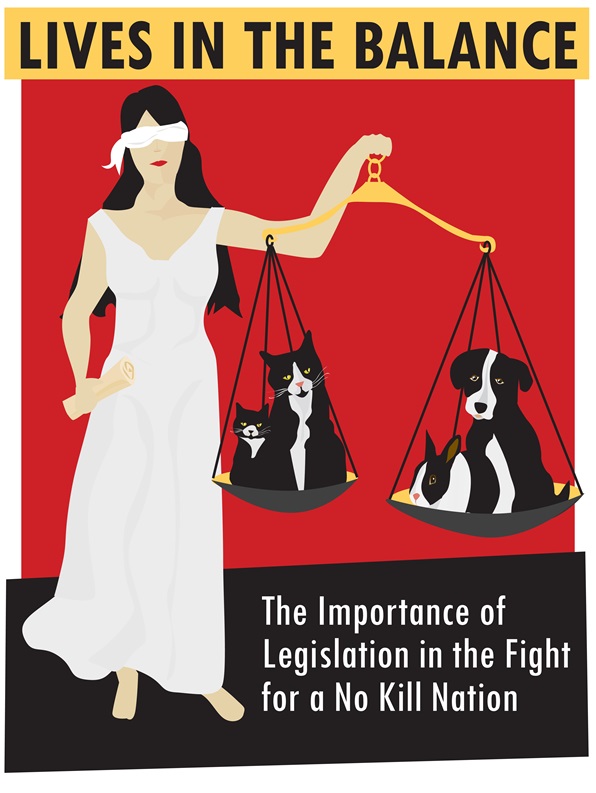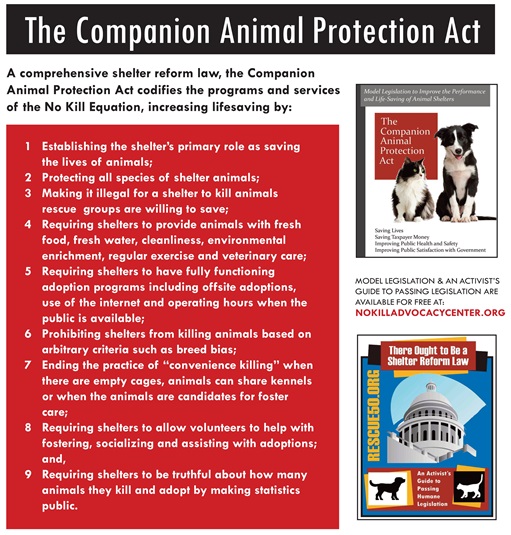
Excerpted from Friendly Fire by Nathan & Jennifer Winograd.
With the number of No Kill communities multiplying and a public that is increasingly savvy about the true causes of shelter killing, there is no doubt that the No Kill movement is coming into its own. The “adopt some and kill the rest” paradigm which has dominated the country is being upended and with it, the call for new leaders to replace regressive ones. But to fully destroy it, to ensure a more humane future for all posterity, we need more than individual leaders passionate about saving lives. We need more than additional directors willing to implement the No Kill Equation. The goal is to permanently build a more compassionate society for animals, to end their killing in shelters now and forever.
Today shelters are permitted to kill most animals who come through their doors. It doesn’t matter if they are healthy or sick, young or old, friendly, scared or traumatized, the choice is up to the people running those shelters. With some small exceptions, if the animal was surrendered by a family, he or she can be killed within minutes of arriving. Not even a meager holding period. No chance at adoption. No food, water or shelter, just a trip from the front counter to the gas chamber or to be poisoned with an overdose of barbiturates.
If the animal came in as a stray, he or she will be held from 48 hours to one week depending on the state, and then that animal can also be put to death with no opportunity or chance for adoption—just a one-way ticket to the morgue. In the communities which have embraced the No Kill philosophy, they’ll be held until they find a home, but that is the exception. Nationally, shelters will find homes for only about half of all animals. In some communities, it is less than 10 percent. And it all depends on who is in charge, on how much they care, on how committed they are.
The No Kill movement has made tremendous progress, to be sure. But in too many communities, we still have this:
I tried to adopt from my local shelter, but they weren’t open on the weekend, it was almost impossible to reach them on the telephone and when I did, I was treated rudely. Nonetheless, I raced down there one day after work, and the place was so dirty. It made me cry to look into the faces of all those animals I knew would be killed. But I found this scared, skinny cat hiding in the backof his cage and I filled out an application. I was turned down because I didn’t turn in the paperwork on time, which meant a half hour before closing, but I couldn’t get there from work in time to do that. I tried to leave work early the next day, but I called and found out they had already killed the poor cat. I will never go back.
We can end this. The aim of every social movement in our nation’s history has been legislation to gain and then protect the rights of its members or the focus of its efforts, a legacy which reaches back to the very founding of our Republic: a more compassionate society, a democracy, the ability to end injustice through self-rule as codified in law. It is a legacy that is at the core of who we are and how we effect change: a government of the people, by the people, for the people. Our system of government was designed not only to solidify the ideals of the American Revolution, but to change with the changing times, a flexibility envisioned by James Madison, the Father of the Constitution, who stated, “In framing a system which we wish to last for ages, we should not lose sight of the changes which ages will produce.”
No matter what the issue: the fight for democracy as epitomized by Madison, Benjamin Franklin and John Adams; the abolition of slavery as epitomized by William Lloyd Garrison, Harriet Tubman, Sojourner Truth and Frederick Douglass; the struggle for women’s suffrage as epitomized by Susan B. Anthony, Elizabeth Cady Stanton and the great Alice Paul; an end to child labor as epitomized by Lewis Hine; civil rights as epitomized by Dr. Martin Luther King Jr. and Harvey Milk; or disability rights as epitomized by Justin Whitlock Dart, Jr. and Richard Pimentel; all these movements culminated in the passing of laws.
The goal was never mere promises that we would strive to do better as a society. The focus was always on changing the law to eliminate the ability to do otherwise. The suffrage movement did not seek discretionary permission from election officials to vote, an ability that could be taken away. Its goal was winning the right to vote, a right guaranteed in law. The civil rights movement did not seek the discretionary ability to sit at the front of the bus or to eat at the same lunch counters. Its goal was winning the right to do so, a right guaranteed in law. Without legal rights, one’s fate is contingent on who the election official is, who the restaurant owner is, who the mayor is and in the case of animals entering shelters, who the director is.
While the ideal animal law would ban the killing of animals in shelters, given that local and state governments may not pass such sweeping laws at this time in history, advocates must begin by seeking legislation that forces shelter leadership to operate their shelters in a progressive, life-affirming way. With rigorous and comprehensive mandates codified in law comes accountability. And with accountability comes an end to the tragic killing of millions of animals each and every year. When shelter directors no longer have discretion to neglect and then kill animals, the era of the status quo will be over.
For further reading:
———————————————-
What You Can Do

In traditional U.S. animal shelters, animals are killed out of habit and convenience. They are killed to keep cages empty so staff don’t have to clean those cages or feed the animals inside them. They are killed rather than given to non-profit rescue organizations who have asked to save them. And they are killed because shelter directors don’t want to make the effort to implement all the other alternatives that already exist. Killing is occurring because it is easier and because as obscene as that reason is, they have been allowed to get away with it. No more. A bill in the Rhode Island legislature would ban convenience killing. A bill in Florida would mandate transparency. A bill in Illinois will ban breed discrimination. Bills in Texas and New York would mandate rescue access. Bills in Minnesota and West Virginia would do all these things and more, such as ban the immediate killing of “owner-surrendered” animals. And we are just getting started. Over the next month or so, you’ll see more bills in more states. But your help is needed.
Learn about the Companion Animal Protection Act by clicking here.
Learn about how to use the legislative process to effect change by clicking here.
Learn how to counter the opposition by clicking here and here.
An if you need help getting legislation introduced in your state, start here.
A No Kill nation is within our reach.
—————-
Have a comment? Join the discussion by clicking here.
My Facebook page is facebook.com/nathanwinograd. The Facebook page of my organization is facebook.com/nokilladvocacycenter. Many people mistakenly believe that the Facebook pages at No Kill Nation and No Kill Revolution are my pages. They are not.